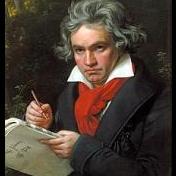Search the Community
Showing results for tags 'wip'.
-
Thoughts on my current rough-drafted ideas / progress on a new symphony orchestral score I'm working on? I've updated the structure of it in it's entirety, and have decided to take a different approach on it's design flow... Haven't really come up with much else beyond this point. But I'd like to hear some feedback regarding the current feel of it. There are still some areas where the notation hasn't been filled in all the way, for some measures/chords. So disregard anywhere that feels "thin" :) Thanks in advance 😉 New(2).pdf New(2).mp3
-
Hello, I have been pretty in the mud on this piece I am writing. I had good steam, but fell off a bit. I really like this concept of romantic/Mahler but messed up, and I like the material I have here. I am going to pick it up to start working on it again for a call for scores I want to submit it to, but I just wanted to ask for some of your thoughts before I get into again! Score: https://www.dropbox.com/scl/fi/qc63mx6he5pmvk4yt0cyn/01-Full-score-Sketches-to-Get-Me-in-the-Mood-of-Orchestra.pdf?rlkey=pky0orqwjilgwpa7hvryogd2r&st=tnmyoyex&dl=0 Audio: https://www.dropbox.com/scl/fi/zqukrchsclku4ks013755/Orchestral-Sketches-Version-7.19.24-WIP-Piece.mp3?rlkey=ut6qrhh3exlfejca6rh6yl2ix&st=mx2dxwhl&dl=0
-
I know I haven't finished symphony 2 or 3, but I was just so inspired by the material, I had to work on it. This is probably my most traditional (especially in structure) symphony so far, probably due to my analysing Beethoven symphonies and sonatas, reading sonata theory, and studying Fux's treatise on counterpoint. The movements are a sonata form first, followed by a scherzo, then the slow movement. There's a program, but it doesn't affect the music much, (introduction and exposition as well as the overall character of the inner movements are as far as the program goes). A rundown of the program: A few years ago, I found on my garage floor an abandoned, injured baby mouse. I wanted to rescue it, but my mom refused to do anything about it, and I was so distraught. I had never felt this way, knowing that I had the power to help the little creature, but being too afraid to go against my mother. I eventually disobeyed her, and I called a local animal rescue group. I sat with the mouse for hours to keep him company until she arrived. She took care of him and sent me update pictures until it was time for him to be released. She gave the mouse to me since I had found him, which I'm grateful for. I released him by an apple tree, and I sometimes regretted not keeping him, but I know he was probably content in the wild and my mother would not have approved anyway. The whole experience affected me deeply, even though looking back people have been in much more extreme animal rescue situations. And maybe my music is a bit melodramatic for this, but I sketched the intro and exposition immediately afterward, so the emotion was still fresh and raw. Specific program notes: The introductory crash represents my surprise when I first found him. The English Horn melody is the mouse, and the first and second theme are sad and then angered, because I was first sad for the mouse would likely die, and then angry because I was restricted from helping. The rest is absolute music and just develops the material. The middle movements are lighter because they represent the period where he was being taken care of. I have no idea what to do for the fourth movement, so I'll probably leave it for now and work on my other music. Also, sorry for the somewhat low-quality audio, I don't have too many opportunities to MuseScore 4, (it's on my parents' computer, my laptop can't handle it). (This is an expansion from a previous version linked here.)
-
Hey everyone! Sorry I've been absent from these forums for a while focusing on school work and... writing a symphony! I started writing this work back in November 2022, beginning with the 3rd movement (the Adagio Molto), and have been toiling away at it ever since. The work is a semi-autobiographical programme symphony with great influence from the likes of Beethoven (daddy😏), Mahler and Berlioz. It tells the story of a Protagonist who travels to America from Europe, meets a young woman, falls in love, leaves America, becomes depressed, returns later in life and marries her. My favourite bit is the 3rd movement- the funeral march- because it is the most idiiomatic and most effectively communicates my message. Plus I spent almost all of my time on it. This symphony is close to being done, what I'm sharing is my third full draft. Some of the openings, transitions and endings still need to be reworked, and I'm sure there are plenty of notation errors that I've missed, as well as more articulation markings etc to add. I'd be grateful for any constructive criticism on the musical and non-musical side as this will form part of my portfolio for conservatoire application here in the UK. Also tell me what you like (if there is anything). I have attached the score in pdf, the sibelius sounds rendering in mp3 and a sample of the programme in pdf. I look forward to seeing what you have to say, and to review more work on these forums again myself! -Charles
-
Over half a year ago I posted the introduction of my second symphony that I've been working on since mid-2021 on this forum. I got some pretty good feedback, so what I'm sharing here is the changes I've made since then plus new stuff. I will also explain the structure of the whole piece. It is in one movement. The structure is kind of two tragic sonatas intertwined. I have an introduction, exposition 1, development 1, exposition 2, development 2, recapitulation of all themes, coda. And if any of you don't know what tragic sonata form is, it's just sonata form but the order of the themes in the recapitulation is reversed. So, the recapitulation of mine will be theme 4, 2, 3, and then one. I have gotten the introduction, first exposition, and first development to a point I'm comfortable sharing. btw I will not be putting this into musesounds until I'm done with the whole piece, since it takes a long time to do that. I'm especially wanting to improve the orchestration, counterpoint, and (sorry if this is vague) subtlety. Feedback is greatly appreciated and don't be afraid to be critical, it will most likely be of help.
- 5 replies
-
- 1
-

-
- symphony
- unfinished
-
(and 1 more)
Tagged with:
-
Hello, lovely people of YCF. I'm currently working on a major project: a violin concerto (my first!) for a friend and accomplished violinist. I am somewhat out of practice in all this, having been "away from keyboard" (i.e., not composing) for two years, so I'm not entirely sure how much of my inner music critic I should trust. That's where you come in! I've attached what I've completed thus far — the first two "movements," though I use the term loosely as I intend the entire piece to be played without pause. (Andante con moto for the first 2 minutes of the recording and moderato assai for the final 2.) I'd like to know how well (or poorly) you feel the music flows here. Are the phrases too short? Do you feel the spacing between the tutti sections (the orchestral "bangs") should be increased? Do you find the Andante section not developed enough? For the violinists out there, would you find the solo part interesting / any fun to play? It sounds okay to my ears, but again, there's a part of me that's second guessing. I feel like the Andante could possibly be lengthened... although it is an introduction and I didn't want the listener to get stuck in its languishing mood. But maybe it's embarrassingly short... decisions, decisions. (FYI the 2nd "movement" is not complete, it's just as far as I've gotten. Furthermore, the piece will likely have 6 or 7 "movements." It all depends on how much development I feel is needed.) If you require a score for some reason, I can provide one — imperfect though it is. Feel free to comment on overall impressions; I find those very useful, as well! Also, don't hesitate to ask questions if you have them. Thanks in advance for all your help!
-
So, I have made some significant progress in composing my Romantic Dance Suite that I mentioned here: A little of this progress is in the Polonaise, but most of the progress I have made is in the second dance, the Mazurka, of which I wrote down 40 bars in 1 hour. That's like the fastest I've ever composed a piece. Even my Minuet, another short dance, wasn't that fast in composition rate. So far I have this structure: A |: B A : | of a piece that I think will end up in this structure: A |: B A : | |: C A : | a simple Rondo Form typical of short Rondos and Rondo form pieces. Even my A section can be broken down into 2 periods and 4 phrases, like this: If I do a Double, as I am considering doing(I would consider doing it for the Waltz too, but I'm not there yet), that would mean most likely Mazurka II being in the parallel minor, which means that the C section of Mazurka I probably shouldn't be in the parallel minor. I just feel that it needs the minor key contrast though. I guess the relative minor or the mediant minor will do. Or maybe the chromatic mediant of F# minor? I'm unsure which minor key to go with, just that I want a minor key contrast other than the parallel minor for the C section, as the Double would be in the parallel minor. I know what a Double is, it's a second dance, usually Baroque, that develops the same melodic material in a different way, the 2 most common Doubles I have seen are that of Diminution(Polonaise of Orchestral Suite no. 2 in B minor) and Parallel Minor(Bouree of Cello Suite no. 3 in G major). Anyway, what do you think of my Mazurka thus far? And what about the key for the C section? As I said before, I'm unsure which minor key to have the C section in. How well do I do that V7/V -> V7 -> I move in Bar 24? Anything I can improve about that V7/V -> V7 -> I motion in Bar 24 or other parts of the Mazurka thus far(I'm thinking of adding some staccato in the dotted rhythms)? Does it feel as though the accent is on the weak beats, because that's important in distinguishing a Mazurka from a Waltz is the accent on weak beats? I will add dynamics later on, they always come after the notes and articulations in my compositional process.
- 4 replies
-
- 1
-

-
- romantic era
- mazurka
-
(and 2 more)
Tagged with:
-
I'm composing this piece for a challenge where the challenge is to compose a romantic piece(romantic in the sense of love, not necessarily the era). What I think about when I think about romantic love is a complicated process that starts with sudden desire(pickup in momentum in the cello leading to harmonization in sixths is what I did to try to get that across), a friendly stage with exchanges, a lot like a friendship but deeper(this is what I'm at now in my piece, an exchange of 2 motives between the flute's motive from the first theme and a second motive in the cello, like 2 people exchanging ideas and seemingly a state of agreement(acceleration towards the cadence in both motives)), a state of anger and not wanting to be with the other person, and a final calming realization phase when true love is reached. This fits well with Sonata Form and so my piece is probably going to end up in Sonata Form, just unconsciously, because of the associations with the start of a romantic relationship. And Flute and Cello are 2 of my favorite instruments. I can't say that I have a favorite woodwind though, they are all great, except maybe the Recorder. But the Cello is my favorite string instrument. Yes, I know, the flute motive slowly shifts across the beats of 4/4 in the first 10 bars. That metric shift just kind of naturally arised from me developing the motive into the flute dominant First Theme. I am stuck though at the cadence in the next 8 or 9 bars. It feels like the Cello wants to continue rising in pitch as does the Flute, as well as accelerate even further to the cadence. But I'm not sure what to do. It's mainly the Cello I am concerned about. It's approaching treble register pitch and the treble register is hard, even for an experienced cellist(Eb4 is not that far off from G4, the note at which I would consider possibly putting the cello in Treble Clef). Right away you might be like: to which I would be like: So, what do you think of my piece so far? Any advice regarding the acceleration to the cadence? Are the 32nds in the Cello motive too fast?
-
So, I've made significant progress in this Gavotte over 5 days. This is how I've progressed over the past 5 days: Day 1: First Phrase melody and bass Day 2: Second Phrase melody and bass Days 3 and 4: Thinking about what to do for the B section, listening to more Baroque Suites, especially Gavottes, even playing some Gavottes on the piano Day 5: Third and Fourth Phrase melody and bass, First and Second Phrase countermelody Not all of my countermelody ideas worked out, but a few of them, like the inversion idea did work. One that didn't work out like I hoped is the suspension chain idea. I mean it kind of worked, but what I was going for was like an F# followed by an E or some other diatonic note in a suspension chain and only the F# suspension worked. I did get a chain of 2 suspensions with the C and B though, so not a total failure, just not what I was going for initially. I used another tied note to prevent parallel octaves and have a stepwise motion in bars 11 and 12. The countermelody I have though is just a draft and is unlikely to be the final countermelody when the Gavotte is finished. I was mainly going for a balance between leaps and steps, richer harmony, and no parallel octaves. And I made sure that if the countermelody got a ninth or further from the main melody, that it was at most an octave away from the bass. At first, I was a bit worried that I'd have to change the bass line, but somebody else told me that the motion of the left hand reminds them of the Baroque, so I've left the bass line as is. You can tell which line is the countermelody, because it has all the stems pointed down. I haven't decided yet if I'm going to double the Gavotte and have Gavotte II in G minor followed by a Da Capo to Gavotte I, but this Gavotte is going to be part of a suite. Here's my Gavotte as of now.
-
Here's a piece I've been working on the past few days, an Adagio in E Minor for solo piano. I've reached the C minor section(that's where the momentum in the bass picks up to the point of me not marking the pedal so it doesn't get muddy). I was aiming for that "stable but not so stable" kind of feeling in the A minor section that starts at bar 40. I've thought of adding a second voice to the right hand starting in bar 17 where the E minor melody is taken up an octave, but I'm not certain if it should be above the original melody, below it, or a mixture of both, I just know that I think it needs a second voice there. There's a chromatic lament bass starting in bar 28 and then the melody comes back in bar 32. Bars 48-58 seem almost chorale-like to me, like I should turn the right hand melody into a string of chords. What do you think of the piece so far? I haven't put in the dynamics yet, but that's because dynamics are one of the last things I add to my compositions followed only by slurs. Notes and articulations come first. I can hear the dynamic arc within the piece and that arc is what I go by when it comes time to add the dynamics. One thing I'm wondering in terms of the pedaling is if I should mark that the pedal is to be absent in bar 62. I mean, I know that sometimes, even without a pedal sempre marking, the pianist will continue pedaling where it isn't marked and bar 62 isn't really suited for pedaling because of the C minor scale in the bass. And come to think of it, how would I mark that the pedal is to be absent?
-
Once again I need your feedback. This is more of an epic/cinematic piece I have been working on for the past few days and would like your opinion. I am not sure I like the beginning. The pad seems to not have enough dynamic to it, too high...etc. but I'm not sure. The piano seems a bit off sync, but it seems to be in the pace of the repeating pattern I use throughout, so I'm not sure whats happening there, or if my ears are hearing something off when it isn't. Title suggestions also welcome. Thank you for your time! https://soundcloud.com/karisalclark/the-storm-chaser-wip/s-YtSyLFuFiLk 5/24 UPDATE: I posted an updated version so you can compare the two: https://soundcloud.com/karisalclark/the-storm-chaser-by-karisa-l-clark/s-f7MfjWF5dQm I have a sort of habit of dropping a song right at the height of it (sudden drop of the song). Is that what I did here? Or did I end it alright?
-
So, one thing I like to do to strengthen skill sets is mess around and just create things that focus on whatever it is that I'm wanting to strengthen in my writing. This particular beginning is focused on orchestration. I've got the winds interlocked in the tutti chords (tonic: d minor). Following these, I bring celli, bass, 2nd violins, and viola in with an accompaniment pattern (doubled with bassoon). Clarinet and Oboe share a resonant countermelody as the flute and violins present the initial theme. Horns, in this example, add punctuation to the rhythmic motif found in the celli.
- 3 replies
-
- wip
- orchestration
-
(and 1 more)
Tagged with:
-
I have been assigned to create(arrange) this piece, I am worried it is too dissonant and a bit too unfamiliar. I changed the instrument sounds because it is easy for me to work with any other sound than the default vocal samples. Any constructive feedback is welcome.
-
Hi, I'm new. I'm currently composing a soundtrack for a video game in early development, and I've started a new composition and completed the rough draft for the climax of the song. If there are any suggestions of anything I should tweak, I'd gladly hear it. I plan to add some sort of percussion
-
I figured that I would start this thread since I am making significant progress with my orchestration of Eine Kleine Nachtmusik. You will notice that most of the notes in any staff are taken directly from the quartet score and put into suitable octaves for the instrument. With this thread, you will be able to see how I have progressed with it because I will post an MP3 and PDF once I finish a section. So far, I have the exposition of the Allegro movement orchestrated. I am working on the development section right now. I have decided on this instrumentation for it: 2 flutes 2 oboes 2 clarinets 2 bassoons 2 horns 2 trumpets Tympani 1st violins 2nd violins Violas Cellos Double basses Here is my first draft of the exposition. How well have I orchestrated it? What issues are there with my orchestration? I vary the instrumentation where Mozart simply repeats the phrase.
-

piece for concert band
Liam Doyle posted a topic in Incomplete Works; Writer's Block and Suggestions
Working on a piece for my concert band. I've had writers block for a couple of weeks now and I just wanted some thoughts/opinions/advice that could motivate/inspire me to finish it. What do you think? -
I have decided to make a progress post for my suite so that I can get feedback on each of the movements without having to make multiple posts. This starting post will be about the first movement of my suite. I initially planned for the melody to not be in ternary form while the harmony was in ternary form, but the melody ended up being in ternary form. I chose the key of G major because it sounds warm to me. To reinforce this, I decided on the instrumentation being string quartet + piano. I use a sequence to modulate from G major to D major as a transition into the B section. So, I guess you could call it ternary sonata form, whatever that means. I include a short canonic passage in the B section of the piece after I have established D major as the tonality. Afterwards, there is a short transition back to the A section. This emphasizes the subdominant and even includes plagal motion. After the themes of the A section are played, there is a passage that includes 2 creschendos. And then the movement ends with a plagal cadence at fortissimo. What do you think of it? Did I get that warm, sunny quality that I was aiming for? Here are the mp3 and pdf:
- 3 replies
-
- chamber music
- chamber ensemble
-
(and 1 more)
Tagged with:
-
This is an arrangement that I have been thinking about doing since winter of last year. No, not because the Nutcracker Suite is common as Christmas music, but rather because the Nutcracker Suite is my favorite of Tchaikovsky's 3 famous suites. Instead of starting with the March as most piano arrangements do, I decided to start with the Overture. I couldn't find many piano arrangements that included this so I decided to go from the orchestral score and arrange it myself. But I ran into a difficulty after a while. No it isn't the clarinet part and me having to transpose it. No, it is the entrance of the entire orchestra. So, I decided to highlight different parts of the orchestra. 2 distinct voices are highlighted the same color because I ran out of colors to highlight with(but you can tell the difference because one of them is almost all 16th note staccatos). So here are my score arrangement, both mp3 and pdf, and the pdf of the Overture with the highlighted areas. Pages 4 and 5 are where I have highlighted distinct voices in the orchestral texture. The ones highlighted in blue and green I think would be obsolete in a piano duet arrangement, especially the one highlighted in green since it is just the same note being repeated over and over. What do you think of my arrangement of the Overture so far? I know it is all treble clef but that has to do with the fact that there are no cellos in the overture and it goes pretty high up, high enough to consider me having it in treble clef instead of bass clef. I know I could just lower the notes that originate from the viola parts down an octave and it would fit perfectly into the bass clef but I'm just not sure that I should do that.
-
- classical music
- arrangement
-
(and 1 more)
Tagged with:
-
This is a WIP of the opening for a new game I am composing. The opening scene is a deputy in a blizzard/winter storm that seeks shelter in a town. The main tune is prominent with the strings, but can be heard throughout. This game takes place in the 1880s. The story is about a deputy who goes to a town that has a pandemic of mercury poison due to a mining operation higher up on the mountain and he eventually becomes insane because of the mercury that is affecting the water, fish, and even the agriculture in the area. Note: I rendered this on a laptop in a lower quality. The final version will be recorded and rendered with the appropriate hardware and software. Any comments, critique, or advice are welcomed. Thanks for listening! Also, you are a badass 😉








